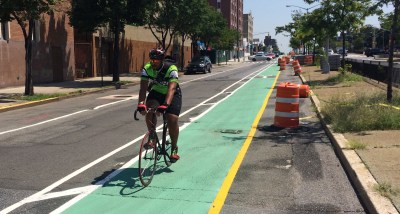The Health Care Cost of Traffic Crashes, and More Ped Injury Summit Tidbits
Here is more from last week’s pedestrian injury summit at Elmhurst Hospital.
NYC DOT Infrastructure: Ann Marie Doherty, NYC DOT chief of research for implementation and safety, highlighted the agency’s 2010 pedestrian safety study and action plan. Doherty said DOT is working to get laws passed related to side guards on trucks, to keep people from being crushed under wheels, and tougher penalties for recidivist reckless drivers and people who drive without a license. A split-phase signal, which gives pedestrians exclusive crossing time, has brought a 63 percent reduction in pedestrian injuries at W. 23rd Street and Seventh Avenue, Doherty said. Streetsblog asked if DOT would be replicating the successful split-phase model at other intersections. Doherty said such decisions are made on a case by case basis, depending on pedestrian activity and other engineering considerations. Doherty said DOT has funding to install pedestrian countdown clocks citywide.
Safe Routes to School: Charles DiMaggio, epidemiologist from Columbia, presented findings from a Safe Routes to School study. Schools that get the Safe Routes treatment show a 44 percent decrease in injuries, DiMaggio said, while those that don’t show no change. DiMaggio estimates the program has saved $19 million in health care costs, and will mean 6,228 additional quality-adjusted life years over 50 years. “Kids can still be kids and be safe,” said DiMaggio.
National Data: Reps from the National Highway Traffic Safety Administration talked up the agency’s “Everyone Is a Pedestrian” program, which awards small grants to help cities develop pedestrian safety plans, and the Data-Driven Approach to Crime and Traffic Safety, developed in partnership with the Department of Justice to study links between traffic violence and other types of crime. Traffic crashes are the leading cause of injury deaths in the U.S., said NHTSA regional administrator Thomas Louizou and highway safety specialist Shannon Purdy. In 2012 pedestrian deaths accounted for 14 percent of all traffic deaths, the highest percentage since 2003. NHTSA data show 48 percent of fatal pedestrian crashes in 2012 involved alcohol — but that stat equates drunk drivers with alcohol use by deceased pedestrians. Though there is no legal BAC limit for walking, NHTSA classified 36 percent of pedestrians killed by drivers in 2012 as “legally drunk.” Fielding a question on what the feds are doing about factory-installed driver distraction systems that now come standard on many U.S. vehicles, Louizou cited voluntary guidelines issued earlier this year by U.S. DOT. Louizou said traffic crashes are “one of the leading causes of rising health care costs in America.”
FDNY EMS: Deputy Chief Janice Olszewski, EMS borough commander in Queens, said FDNY responds to over 24,000 “pedestrian struck” calls per year. That figure includes people who are hit by trains and other crashes that don’t involve cars and trucks, Olszewski said. (Over 14,000 pedestrians and cyclists were injured by NYC drivers in 2012.) Two-thirds of victims are transported. To help determine the type and extent of injuries, Olszewski said, responders interview the patient (if possible), inspect vehicles, and get witness accounts — which is more than NYPD precinct officers are trained or authorized for at the scene of an injury crash. (An NYPD official slated to speak at the summit was a no-show.)
DOT Safety Education: There was a lot of talk about reckless drivers at the summit, but when the topic of responsibility was broached at all, the general tone was that pedestrians and cyclists bear equal responsibility, at least, for being injured and killed. NYC DOT data show 78.5 percent of serious pedestrian crashes are caused primarily by driver behavior, but at the summit agency officials repeatedly touted the city’s “distracted walking” campaigns. A new program called “Cross This Way,” developed in partnership with Toyota, aims to stop kids from texting or otherwise using electronic devices while walking. With a video (not yet released) and accompanying classroom materials, DOT will advise kids, among other things, against crossing the street with a walk signal without first stopping to make sure no cars are headed in their direction. Allowing that drivers “may go through a red light once in a while,” DOT deputy director of safety education Marjorie Marciano called pedestrian and cyclist safety a “three-way street.” The “Cross This Way” campaign, Marciano said, will tell kids that “drivers have the right to turn while you have the pedestrian signal in your favor.”
Transportation Alternatives: Jennifer So Godzeno, planning director at Transportation Alternatives, said that 45 percent of New Yorkers own cars, and about half of those who own cars drive them regularly — yet the motoring minority is given undue deference when it comes to allocating public space. Godzeno cited TA’s Crash Stories web site, where pedestrians and cyclists can self-report crashes and near misses. She lauded the DOT Slow Zone program, but said slowing down drivers should be the rule, not the exception. “You shouldn’t have to beg the city for safer streets,” Godzeno said.

